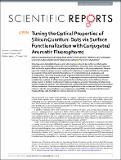Files in this item
Tuning the optical properties of silicon quantum dots via surface functionalization with conjugated aromatic fluorophores
Item metadata
| dc.contributor.author | Abdelhameed, Mohammed | |
| dc.contributor.author | Rota Martir, Diego | |
| dc.contributor.author | Chen, Shalimar | |
| dc.contributor.author | Xu, William Z. | |
| dc.contributor.author | Oyeneye, Olabode O. | |
| dc.contributor.author | Chakrabarti, Subrata | |
| dc.contributor.author | Zysman-Colman, Eli | |
| dc.contributor.author | Charpentier, Paul A. | |
| dc.date.accessioned | 2018-02-15T10:30:12Z | |
| dc.date.available | 2018-02-15T10:30:12Z | |
| dc.date.issued | 2018-02-14 | |
| dc.identifier | 252171493 | |
| dc.identifier | b94239e6-4068-4791-85b4-7b12bfc4b9c1 | |
| dc.identifier | 85042097759 | |
| dc.identifier | 000424985800088 | |
| dc.identifier.citation | Abdelhameed , M , Rota Martir , D , Chen , S , Xu , W Z , Oyeneye , O O , Chakrabarti , S , Zysman-Colman , E & Charpentier , P A 2018 , ' Tuning the optical properties of silicon quantum dots via surface functionalization with conjugated aromatic fluorophores ' , Scientific Reports , vol. 8 , 3050 . https://doi.org/10.1038/s41598-018-21181-8 | en |
| dc.identifier.issn | 2045-2322 | |
| dc.identifier.other | ORCID: /0000-0001-7183-6022/work/56639123 | |
| dc.identifier.uri | https://hdl.handle.net/10023/12722 | |
| dc.description | The authors acknowledge Karen Nygard at UWO Biotron for assistance with confocal microscopy. This work was financially supported by NSERC Canada Discovery (Charpentier). | en |
| dc.description.abstract | Silicon Quantum Dots (SQDs) have recently attracted great interest due to their excellent optical properties, low cytotoxicity, and ease of surface modification. The size of SQDs and type of ligand on their surface has a great influence on their optical properties which is still poorly understood. Here we report the synthesis and spectroscopic studies of three families of unreported SQDs functionalized by covalently linking to the aromatic fluorophores, 9-vinylphenanthrene, 1-vinylpyrene, and 3-vinylperylene. The results showed that the prepared functionalized SQDs had a highly-controlled diameter by HR-TEM, ranging from 1.7–2.1 nm. The photophysical measurements of the assemblies provided clear evidence for efficient energy transfer from the fluorophore to the SQD core. Fӧrster energy transfer is the likely mechanism in these assemblies. As a result of the photogenerated energy transfer process, the emission color of the SQD core could be efficiently tuned and its emission quantum efficiency enhanced. To demonstrate the potential application of the synthesized SQDs for bioimaging of cancer cells, the water-soluble perylene- and pyrene-capped SQDs were examined for fluorescent imaging of HeLa cells. The SQDs were shown to be of low cytotoxicity. | |
| dc.format.extent | 2092380 | |
| dc.language.iso | eng | |
| dc.relation.ispartof | Scientific Reports | en |
| dc.subject | Silicon Quantum Dots | en |
| dc.subject | Energy transfer | en |
| dc.subject | Photoluminescence | en |
| dc.subject | Bioimaging | en |
| dc.subject | QD Chemistry | en |
| dc.subject | NDAS | en |
| dc.subject | SDG 3 - Good Health and Well-being | en |
| dc.subject.lcc | QD | en |
| dc.title | Tuning the optical properties of silicon quantum dots via surface functionalization with conjugated aromatic fluorophores | en |
| dc.type | Journal article | en |
| dc.contributor.sponsor | EPSRC | en |
| dc.contributor.institution | University of St Andrews. School of Chemistry | en |
| dc.contributor.institution | University of St Andrews. Organic Semiconductor Centre | en |
| dc.contributor.institution | University of St Andrews. EaSTCHEM | en |
| dc.identifier.doi | https://doi.org/10.1038/s41598-018-21181-8 | |
| dc.description.status | Peer reviewed | en |
| dc.identifier.grantnumber | EP/M02105X/1 | en |
This item appears in the following Collection(s)
Items in the St Andrews Research Repository are protected by copyright, with all rights reserved, unless otherwise indicated.

